
The Kirkbride Plan was a system of mental asylum design advocated by American psychiatrist Thomas Story Kirkbride (1809–1883) in the mid-19th century. The asylums built in the Kirkbride design, often referred to as Kirkbride Buildings, were constructed during the mid-to-late-19th century in the United States.

The Danvers State Hospital, also known as the State Lunatic Hospital at Danvers, The Danvers Lunatic Asylum, and The Danvers State Insane Asylum, was a psychiatric hospital located in Danvers, Massachusetts. It was built in 1874, and opened in 1878, under the supervision of prominent Boston architect Nathaniel Jeremiah Bradlee, on an isolated site in rural Massachusetts. It was a multi-acre, self-contained psychiatric hospital designed and built according to the Kirkbride Plan.
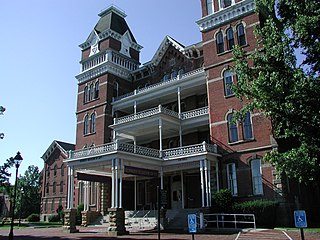
The Athens Lunatic Asylum, now a mixed-use development known as The Ridges, was a Kirkbride Plan mental hospital operated in Athens, Ohio, from 1874 until 1993. During its operation, the hospital provided services to a variety of patients including Civil War veterans, children, and those declared mentally unwell. After a period of disuse the property was redeveloped by the state of Ohio. Today, The Ridges are a part of Ohio University and house the Kennedy Museum of Art as well as an auditorium and many offices, classrooms, and storage facilities.
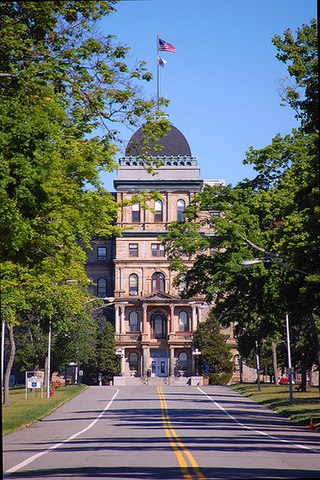
Greystone Park Psychiatric Hospital referred to both the former psychiatric hospital and the historic building that it occupied in Morris Plains, New Jersey. Built in 1876, the facility was built to alleviate overcrowding at the state's only other "lunatic asylum" located in Trenton, New Jersey. Originally built to accommodate 350 people, the facility, having been expanded several times, reached a high of over 7700 patients resulting in unprecedented overcrowding conditions. In 2008, the facility was ordered to be closed as a result of deteriorating conditions and overcrowding. A new facility was built on the large Greystone campus nearby and bears the same name as the aging facility. Despite considerable public opposition and media attention, demolition of the main Kirkbride building began in April 2015 and was completed by October 2015.

The Philadelphia State Hospital at Byberry was a psychiatric hospital located on either side of Roosevelt Boulevard in Northeast Philadelphia, Pennsylvania. It was specifically located in the Somerton section of the city on the border with Bucks County. The name of the institution was changed several times during its history being variously named Philadelphia State Hospital, Byberry State Hospital, Byberry City Farms, and the Philadelphia Hospital for Mental Diseases. It was home to people ranging from the mentally challenged to the criminally insane.
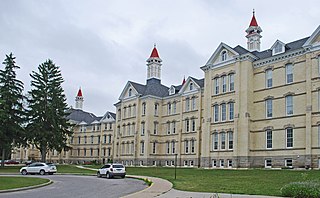
The Traverse City State Hospital of Traverse City, Michigan is a decommissioned psychiatric hospital that has been variously known as the Northern Michigan Asylum and the Traverse City Regional Psychiatric Hospital. It is the last Kirkbride Building of Michigan's original four left in the state. It was listed on the National Register of Historic Places in 1978 and designated a Michigan State Historic Site in 1985.

The Institute of Pennsylvania Hospital, also known as Kirkbride's Hospital or the Pennsylvania Hospital for Mental and Nervous Diseases, was a psychiatric hospital located at 48th and Haverford Streets in Philadelphia, Pennsylvania, USA. It operated from its founding in 1841 until 1997. The remaining building, now called the Kirkbride Center is now part of the Blackwell Human Services Campus.

The Callan Park Hospital for the Insane is a heritage-listed former insane asylum, which was subsequently, for a time, used as a college campus, located in the grounds of Callan Park, an area on the shores of Iron Cove in Lilyfield, a suburb of Sydney, New South Wales, Australia. In 1915, the facility was renamed as the Callan Park Mental Hospital and, again in 1976, to Callan Park Hospital. Since 1994, the facility has been formally known as Rozelle Hospital. In April 2008, all Rozelle Hospital services and patients were transferred to Concord Hospital. The Callan Park Act, 2002 (NSW) restricts future uses of the site to health, tertiary education and community uses.

Thomas Story Kirkbride was a physician, alienist, hospital superintendent for the Institute of the Pennsylvania Hospital, and primary founder of the Association of Medical Superintendents of American Institutions for the Insane (AMSAII), the organizational precursor to the American Psychiatric Association. Along with Dr. Benjamin Rush he is considered to be the father of the modern American practice of psychiatry as a specific medical discipline. His directive and organization of institutions for the insane were the gold-standard of clinical care in psychiatry throughout the 19th century.

Central State Hospital, formally referred to as the Central Indiana Hospital for the Insane, was a psychiatric treatment hospital in Indianapolis, Indiana. The hospital was established in 1848 to treat patients from anywhere in the state, but by 1905, with the establishment of psychiatric hospitals in other parts of Indiana, Central State served only the counties in the middle of the state. In 1950, it had 2,500 patients. Allegations of abuse, funding shortfalls, and the move to less institutional methods of treatment led to its closure in 1994. Since then efforts have been made to redevelop the site for various uses.
Mendota Mental Health Institute (MMHI) is a public psychiatric hospital in Madison, Wisconsin, United States, operated by the Wisconsin Department of Health Services. The hospital is accredited by the Joint Commission. Portions of the facility are included in the Wisconsin Memorial Hospital Historic District, District #88002183. The Mendota State Hospital Mound Group and Farwell's Point Mound Group are also located at the facility.

The Hudson River State Hospital is a former New York state psychiatric hospital which operated from 1873 until its closure in the early 2000s. The campus is notable for its main building, known as a "Kirkbride," which has been designated a National Historic Landmark due to its exemplary High Victorian Gothic architecture, the first use of that style for an American institutional building. It is located on US 9 on the Poughkeepsie-Hyde Park town line.
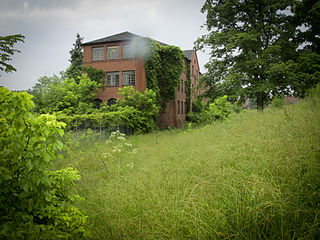
Mayview State Hospital was a psychiatric hospital, originally known as Marshalsea Poor Farm, located in South Fayette Township near Bridgeville, Pennsylvania. It spanned 335 acres (136 ha) and had 39 buildings, 12 of which were used for patient care and hospital administration. It had a staff count of approximately 502 as of August 2007, and an operating budget of $63 million per year. It was demolished in 2016.
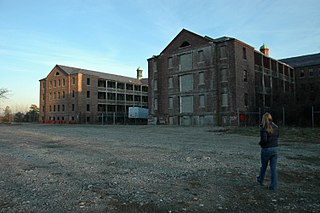
Northampton State Hospital was a historic psychiatric hospital at 1 Prince Street on top of Hospital Hill outside of Northampton, Massachusetts. The hospital building was constructed in 1856. It operated until 1993, and the building was added to the National Register of Historic Places in 1994.

The Western Pennsylvania Hospital, commonly referred to as "West Penn Hospital", is located at 4800 Friendship Avenue in the Bloomfield neighborhood of Pittsburgh, Pennsylvania. The 317-bed hospital is part of the Allegheny Health Network. It serves as a Clinical Campus of Temple University School of Medicine, offering medical education, including a large number of residency and fellowship programs. It is also the primary clinical setting of the West Penn Hospital School of Nursing.

Danville State Hospital in Danville, Pennsylvania is a mental health facility operated by the Pennsylvania Department of Public Welfare. It was Pennsylvania's third public facility to house the mentally ill and disabled.
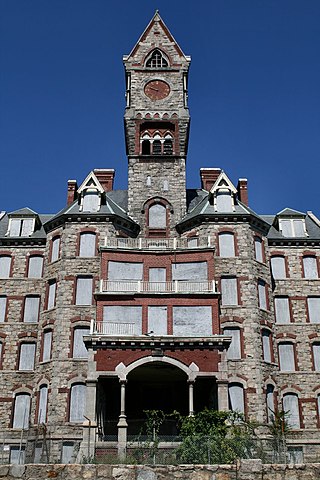
Worcester State Hospital was a Massachusetts state mental hospital located in Worcester, Massachusetts. It is credited to the architectural firm of Weston & Rand. The hospital and surrounding associated historic structures are listed as Worcester Asylum and related buildings on the National Register of Historic Places.

Central State Hospital, originally known as the Central Lunatic Asylum, is a psychiatric hospital in Petersburg, Virginia, United States. It was the first institution in the country for "colored persons of unsound mind".
The Pennsylvania State Hospital System is a network of psychiatric hospitals operated by the Commonwealth of Pennsylvania. At its peak in the late 1940s the system operated more than twenty hospitals and served over 43,000 patients. As of 2011 fewer than nine sites remain in use, and many of those serve far fewer patients than they once did. Many facilities or portions of facilities no longer in use for psychiatric treatment have been repurposed to other uses, while some have been demolished.

Northern Lights Shopping Center is a strip mall located in Economy, Pennsylvania near Pittsburgh. It was a major power center-style strip mall from its opening until the early 2000's. A Walmart opened on the adjacent lot to Northern Lights in 2014. Parts of the plaza were demolished in 2018.




























